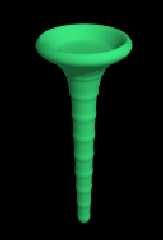|
 |
Hi, i'm currectly trying to do some hand coding, especially blobby blobs. I
can get the general shape I want, but it has ribs in it. how can I go about
getting rid of these? I found negative strength to do what I want on the top
part, that was way cool, i like it a lot. Is there some way I can get rid of
those ribs though? the ones that are on the downward pertruding part of the
object.
by the way, this is not at all supposed to be a golf tee :) i'm serious, so
don't think so! you'll see when i'm done. i'm going to try to hand code an
entire scene so it might be next year when i'm finished.
anyway, thanks for the helparoo.
ross
Post a reply to this message
Attachments:
Download 'blob2.gif' (5 KB)
Preview of image 'blob2.gif'

|
 |
|
 |
It'd help to see the code. Beyond that, I'd suggest playing around with the
threshold a bit, or increasing the number of components between the
base-point and the top. Maybe run them through a loop. ie:
#declare YTran=0;
#declare Scaler=1;
blob {
threshold 0.65
#while (YTran <= 10)
sphere {0,1,1
scale Scaler
translate YTran*y
}
#declare YTran=YTran+0.25;
#declare Scaler=Scaler+0.1;
#end
pigment {rgb <0.65,0.8,0.65>}
}
The more components you use, the smoother the transition.
David
Post a reply to this message
|
 |
|
 |
In doing such shapes I guess the old saying "nothing's ever easy"
would apply.
I wanted to check out what David H. has said here and came up with
the following:
#declare YTran=0;
#declare Scaler=<1,.5,1>;
blob {
threshold .5
#while (YTran <= 10)
sphere {0,1,1
scale Scaler
translate YTran*y
}
#declare YTran=YTran+0.25;
#declare Scaler=Scaler+0.1
*(pow(YTran, .5 / 1)*.5); // borrowed from clockmod.inc
#end
sphere {0,1,-2
scale Scaler*<.6,.8,.6>
translate YTran*y*1.25
}
pigment {rgb <0.65,0.8,0.65>}
translate -6*x
}
// rotate a 2-D outline of points around the Y axis to create a 3-D shape
lathe {
cubic_spline
12, // number of points
// the list of <u,v> points
<0, 0>, // keep end closed
<0, 0>,
<.5, 1>,
<1, 4>,
<2, 7>,
<4.5, 10.25>,
<4, 11>,
<3.25, 10.5>,
<2.75, 10.33>,
<2, 10>,
<0, 10>,
<0, 10> // keep end closed
pigment {rgb <0.65,0.8,0.65>}
translate 6*x
}
#declare LCX = 0;
#declare LCY = 20;
#declare LCZ = -30;
light_source { <LCX,LCY,LCZ> color rgb <1.5,1.5,1.5>
}
camera{
location <LCX,LCY,LCZ>
angle 40
look_at <0,7,0>
}
To make a long story short, I figured a lathe would be better suited
for doing this sort of object. I could never get the negative strength
blob component to do what Ross had there already.
The lathe can be some trouble sometimes to get the curvatures
correct but it does seem the lesser of the two evils to me.
Bob
"David Heys" <sou### [at] gci net> wrote in message news:390f356d@news.povray.org...
| It'd help to see the code. Beyond that, I'd suggest playing around with the
| threshold a bit, or increasing the number of components between the
| base-point and the top. Maybe run them through a loop. ie:
|
| #declare YTran=0;
| #declare Scaler=1;
|
| blob {
| threshold 0.65
| #while (YTran <= 10)
| sphere {0,1,1
| scale Scaler
| translate YTran*y
| }
| #declare YTran=YTran+0.25;
| #declare Scaler=Scaler+0.1;
| #end
| pigment {rgb <0.65,0.8,0.65>}
| }
|
| The more components you use, the smoother the transition.
|
| David
|
|
| net> wrote in message news:390f356d@news.povray.org...
| It'd help to see the code. Beyond that, I'd suggest playing around with the
| threshold a bit, or increasing the number of components between the
| base-point and the top. Maybe run them through a loop. ie:
|
| #declare YTran=0;
| #declare Scaler=1;
|
| blob {
| threshold 0.65
| #while (YTran <= 10)
| sphere {0,1,1
| scale Scaler
| translate YTran*y
| }
| #declare YTran=YTran+0.25;
| #declare Scaler=Scaler+0.1;
| #end
| pigment {rgb <0.65,0.8,0.65>}
| }
|
| The more components you use, the smoother the transition.
|
| David
|
|
|
Post a reply to this message
|
 |
|
 |
Thanks, i figured i'd add a normal, agate is what i tried, to see how it
interacts with real unwanted bumps. it makes things less noticeable atleast,
and for my purposes, adding a normal makes sense. in other cases, it might
not though.
I don't know anything about writting code for lathes, so i'm going to stick
to blobs. i might try using some componants that are scaled heavily in the y
(up/down) direction, or maybe a cylinder componant going all the way down
the middle to see if that smooths things some. i don't know anything about
cylinder componants either :) so we'll see.
thanks for the help,
ross
Bob Hughes wrote in message news:390f50e3@news.povray.org...
> In doing such shapes I guess the old saying "nothing's ever easy"
> would apply.
> I wanted to check out what David H. has said here and came up with
> the following:
>
::snip::
>
> To make a long story short, I figured a lathe would be better suited
> for doing this sort of object. I could never get the negative strength
> blob component to do what Ross had there already.
> The lathe can be some trouble sometimes to get the curvatures
> correct but it does seem the lesser of the two evils to me.
>
> Bob
Post a reply to this message
|
 |




![]()